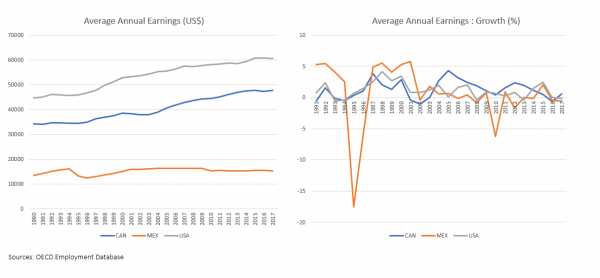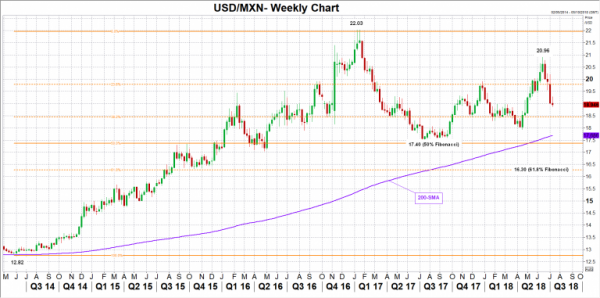Having lost two previous elections, once in 2006 and once in 2012, Andres Manuel Lopez Obrador, the head of the small four-year-old party MORENA in Mexico known by his initials as AMLO turned to be the first leftist president at the July 1st elections since the 1930s, comfortably beating the two traditional parties which dominated the presidency since 2000. While AMLO will mainly have to deal with high levels of crime and inequality plaguing Mexico, his proposals on the trade front are what will likely keep investors on their toes amid rising risks from the US protectionist attitude. On the positive side, the two presidents have now more in common and a new era of partnership could be established. Still, the scene could turn more interesting but with fireworks, if Lopez resumes his tough talk on Trump politics, pushing potentially a new NAFTA deal well into the horizon and therefore bringing fresh downside to the peso.
Winning 53% of the votes compared to a much lower support of 22.5% and 16.4% gained by the opposition National Action Party (PAN) and the Institutional Revolutionary Party (PRI) respectively, the fiscal hawk Lopez promised to enhance the internal market by helping the” country to produce what it consumes” so Mexicans can work and be satisfied in the place where they were born. His patriotic language was similar to the nationalist temper of the US President, with investors speculating that the two leaders could somehow develop sympathy for each other, something that could put the two countries on the same page regarding NAFTA. For example, if Lopez makes some concessions to Trump, backing less migration and higher wages for Mexicans given that annual growth in average yearly earnings in Mexico and the US hasn’t changed much since the birth of NAFTA in 1994, then the now subdued NAFTA talks could speed up, leaving the ball in Canada’s hands to make further concessions. Recall that despite criticizing the free-trade pact many times in the past, Lopez showed no appetite to withdraw from it during his presidential campaign, saying a week ago that he will seek to stay within the agreement along with the US and Canada.
In the alternative scenario, things could turn negative if the new Mexican President judges that US trade tariffs are harming his country’s interests and therefore countermeasures should be implemented. This narrative has been already echoed by his top economic adviser, Graciela Marquez, who is expected to be appointed as the next Minister of Economy. In an interview with Reuters recently, Marquez argued that if the US slaps tariffs on Mexican automobile imports, as Trump proposed, Mexico, which is already subject to US aluminum and steel tariffs since early June, should “raise tariffs in strategic sectors”. Note that the US is Mexico’s biggest export partner, hence any trade barriers from Washington could bring headwinds to the country’s economic growth.
Trump’s famous idea to build a wall at the borders with Mexico could be another reason for the two leaders to fall out. Following Trump’s inauguration in 2017, Lopez published a book named “Oye, Trump” (Listen up, Trump) in which he denounced Trump’s promise to build a wall, while later in the year, speaking in Los Angeles he expressed that the plan “goes against humanity and history”. Moreover, it is worth noting that disagreements around the topic forced the cancelation of a meeting between Trump and the former Mexican president Enrique Peña Nieto in Washington earlier this year. The same thing happened back in 2016 when Trump was still a candidate who had the vision to reduce migration from Mexico, while Peña Nieto was struggling to maintain his popularity; something that he failed to achieve especially after he invited Trump to Mexico, disappointing locals.
Lopez has now to wait five months before he officially takes the presidency in December in cooperation with his coalition partners, the Labor Party (PT) and the conservative Social Encounter Party, a group known as “The Together We Will Make History” coalition. The three parties are also projected to win a parliamentary majority, winning 303 seats out of 500 in the lower house of the Congress and 70 out of 128 in the Senate, making Lopez the first leader since 1997 to enjoy this privilege. While this has brought fears that AMLO could increase tax payments or public debt to achieve his fiscal goals and even go against his predecessor’s reforms in the oil industry which allowed a larger share of foreign investments in the sector, legislative procedures regarding trade issues could speed up since Lopez could comfortably pass his proposals through Congress under this scenario.
In forex markets, AMLO’s victory drove the Mexican peso slightly lower against the dollar on July 2, though, the currency returned to bullish mode the next day after the new president assured he will adopt market-friendly policies and respect the central bank’s independence. Since then the peso continued to attract buying interest, pushing dollar/peso to two-month lows last Friday but its upside move is still under risk as uncertainties around NAFTA are not likely to fade out until US mid-term elections take place in November, a month before AMLO officially starts its presidential term. A larger number of seats for Republicans, for instance, could strengthen Trump’s position and at the same time intensify efforts by the new Mexican leader to persuade Trump to sign a three-part free trade pact, and avoid a bilateral agreement the US president currently seeks for.
However, if Lopez manages to sweeten the deal for the US president in favor of the Mexican labor and trade market, the Mexican peso could enjoy further gains, with dollar/peso searching for support around 17.40 where the 50% Fibonacci of the upleg from 12.82 to 22.03 is placed. A substantial move below that mark would also violate the 200-week simple moving average for the first time since 2013, signaling further downside for the US dollar. In this case, the door could open for the 61.8% Fibonacci of 16.30 which provided some support between August and December 2015.
Alternatively, should the tit-for-tat tariff game continue, with the US pushing Mexico and Canada to agree on a less attractive NAFTA deal which would lower US trade deficit with those countries – as Trump insists – dollar/peso could move back above the 20.00 key level (23.6% Fibonacci), with scope to retest June’s peak of 20.96. Above this level, dollar bulls could run towards the record high of 22.00.
















